Physical Address
304 North Cardinal St.
Dorchester Center, MA 02124
On completion of this chapter, you should be able to:
Discuss the embryology of the thyroid and parathyroid glands
Describe the normal anatomy and physiology of the thyroid and parathyroid glands
Define the relational anatomy of the thyroid and parathyroid glands
Discuss the laboratory values and clinical findings of the thyroid and parathyroid glands
Describe the sonographic examination of the thyroid and parathyroid glands
Differentiate the sonographic features of pathologic conditions found in the thyroid and parathyroid glands
The thyroid gland is an organ of the endocrine system that maintains body metabolism, growth, and development through the synthesis, storage, and secretion of thyroid hormones. A hormone triggers a reaction in a specific, targeted cell. Thyroid hormones include triiodothyronine (T 3 ), thyroxine (T 4 ), and calcitonin. The primary hormones, triiodothyronine (T3) and thyroxine (T 4 ) , stimulate cell metabolism, which is the body’s ability to break down food and convert it to energy. The third hormone, calcitonin , plays a minor role to regulate blood calcium levels. Disorders of the thyroid may result from thyroid gland dysfunction, which is regulated by the pituitary and hypothalamus glands (located in the brain).
The thyroid is located on the anterior lower neck on either side of the midline and is not easily palpated by physical examination. General enlargement of the thyroid gland is called a goiter . A localized enlargement is a nodular goiter , and multiple thyroid nodules are described as a multinodular goiter (MNG) . Both insufficient and excessive secretion of thyroid hormones may cause thyroid gland enlargement.
Because the thyroid gland is superficial, high-resolution sonography is used to evaluate the gland. The examination is easy to perform and is well tolerated by patients. Sonography of the thyroid is used to evaluate gland size, shape, and echogenicity and determine the sonographic appearance of a palpable lesion (i.e., solid or cystic, complex or calcified) and whether the lesion is single or multiple. The nodule size and location and the evaluation of the adjacent anatomy (i.e., lymph node adenopathy) may be imaged. Color Doppler, power Doppler, and pulsed wave Doppler are used to determine vascularity. Thyroid sonography will not determine the physiology of the thyroid gland. The functional state is better determined by nuclear medicine scintigraphy and laboratory measurements of the thyroid hormones present in the blood. Interventional procedures under sonographic guidance, including fine-needle aspiration (FNA) biopsy, are important applications of sonography. Sonographic evaluation of the parathyroid gland and other lesions of the neck will also be presented in this chapter.
The thyroid gland is the first endocrine gland to develop in the human embryo. It develops at the floor of the primitive pharynx at the same location of the base of the tongue. The developing thyroid gland will migrate inferiorly along the anterior neck region to the lower neck anteriorly to the trachea. The migration may leave behind embryonic remnants or ectopic thyroid tissue that should atrophy but may form developmental cysts.
The thyroid gland is located inferior to the thyroid cartilage (Adam’s apple) in the anteroinferior neck. The gland has an “H” or a “U” configuration and consists of right and left lobes that consist of upper, middle, and lower poles that are connected across the midline by a thin bridge of thyroid tissue called the isthmus . The isthmus straddles the trachea anteriorly, whereas the paired lobes extend on either side of the trachea, bounded laterally by the common carotid arteries and internal jugular veins. When present, the pyramidal lobe arises from the isthmus and tapers superiorly just anterior to the thyroid cartilage and may be seen in 15% to 30% of patients ( Fig. 22.1A ). The pyramidal lobe is most commonly visualized in pediatric patients and usually atrophies with age. A fascia surrounds the thyroid, trachea, esophagus, and parathyroid glands (see Fig. 22.1B ).
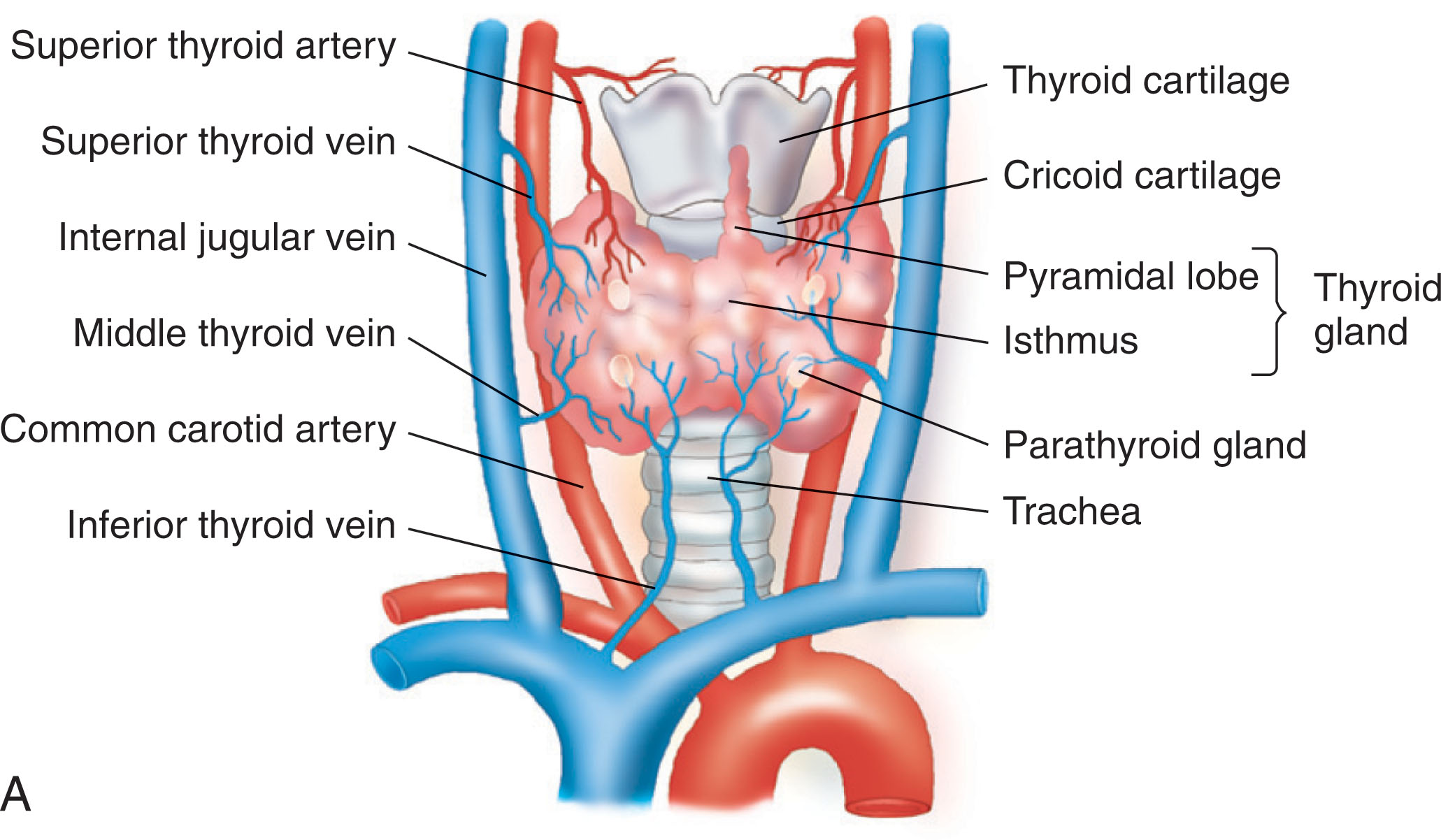
The thyroid gland is made up of two types of cells: follicular and parafollicular cells. Follicular cells make up the majority of thyroid tissue and secrete the main thyroid hormones T 3 and T 4 . The follicular cells require an adequate supply of iodine to produce the correct amount of thyroid hormones. The parafollicular cells (also called C cells) secrete calcitonin.
The size and shape of the thyroid gland vary with gender, age, and body surface area, with females having a slightly larger gland than males ( Table 22.1 ). In tall individuals, the lateral lobes of the thyroid have a longitudinally elongated shape on sagittal scans, whereas in shorter individuals, the gland is more oval shaped. As a result, the normal dimensions of the gland have a wide range of variability. The lobes are normally equal in size. At age 1 year, the mean length is 25 mm, anteroposterior (AP) diameter is 12 to 15 mm, and width is 10 to 15 mm. In the normal adult, the thyroid gland measures 40 to 60 mm in length, 20 to 30 mm in AP diameter, and 15 to 20 mm in width. The isthmus is the smallest portion of the gland, with an AP diameter of 4 to 6 mm. The gland is considered enlarged when the thyroid lobe AP diameter measures greater than 20 mm and when the isthmus measures 10 mm or greater.
| Dimension | Adults | Children |
|---|---|---|
| Length | 40–60 mm | 20–30 mm |
| Anteroposterior | 20–30 mm | 12–15 mm |
| Width | 15–20 mm | 10–15 mm |
| Volume | 10–12 ± 3 mL |
Due to shape variations, the thyroid volume is more useful to determine gland enlargement. The method commonly used to calculate thyroid volume is based on the ellipsoid formula with a correction factor (length × width × thickness × 0.523 for each lobe). The normal mean thyroid volume is 10 to 12 ± 3 mL. The volume in men is slightly more than in women. Volume measurement can be used to assess the need for surgery, calculate iodine-131 dosage for treatment of thyrotoxicosis (a toxic condition resulting from excessive amounts of thyroid hormones occurring in extreme hyperthyroidism), or evaluate the response to suppression treatments.
Along the anterior surface of the thyroid gland lie three strap muscles , including the sternohyoid, sternothyroid, and omohyoid, with the anterolateral sternocleidomastoid muscles (see Fig. 22.1 ).
Directly lateral to each thyroid lobe are the common carotid artery, internal jugular vein, and vagus nerve within the carotid sheath.
Along the posterior border adjacent to thyroid tissue lie the superior and inferior parathyroid glands along with the anastomosis between the superior and inferior thyroid arteries. The longus colli muscle is posterior and lateral to each thyroid lobe along the anterior surface of the cervical vertebrae (see Fig. 22.1 ).
Medial anatomy consists of the larynx, the trachea, and the inferior constrictor muscle of the pharynx. The esophagus is considered an anatomically midline structure but is usually found sonographically to the left of midline lateral to the trachea (see Fig. 22.1 ). It is identified by the target appearance in the transverse plane and confirmed during real time evaluation by its peristaltic movements when the patient swallows.
The thyroid gland is supplied by four arteries and considered highly vascular. Two superior thyroid arteries branch from the external carotid arteries and descend to the upper poles of the thyroid. Two inferior thyroid arteries arise from the thyrocervical trunk of the subclavian arteries and ascend to the lower poles of the thyroid. Corresponding superior thyroid veins drain into the internal jugular veins, and the inferior thyroid veins drain into the brachiocephalic veins (see Fig. 22.1 ).
The role of the thyroid is to maintain normal body metabolism, physical and mental growth, and development by the synthesis, storage, and secretion of thyroid hormones. Every cell in the body depends on thyroid hormones for regulation of its metabolism. The mechanism for producing thyroid hormones is through iodine metabolism. The thyroid follicular cells are the only cells in the body that can absorb iodine. Through a series of chemical reactions, the thyroid produces T 3 and T 4 . Most endocrine glands do not store their hormones, but thyroid hormones are stored in the colloid material of the gland to be secreted when needed into the blood. In terms of amount of hormone secretion, T 4 is more abundant at 80%, whereas T 3 is 20% of secretion; however, T 3 is more potent.
When thyroid hormones are needed in the body, they are released into the bloodstream by the action of thyrotropin, or thyroid-stimulating hormone (TSH) , which is produced by the pituitary gland. The secretion of TSH is regulated by thyrotropin-releasing hormone (TRH) , which is produced by the hypothalamus. The level of TRH is controlled by the basal metabolic rate in a negative feedback system. Low concentration of thyroid hormones causes a decrease in the basal metabolic rate, which results in an increase in TRH. This causes an increased secretion of TSH and a subsequent increase in the release of thyroid hormones. When the blood level of thyroid hormones is returned to normal, the basal metabolic rate returns to normal and TSH secretion stops. In summary, the hypothalamus signals the pituitary gland to tell the thyroid gland to produce more or less thyroid hormones.
Calcitonin decreases the concentration of calcium in the blood by first acting on bone to inhibit its breakdown of calcium. When less calcium is being resorbed into the blood, less calcium moves out of the bone into the blood with a decrease in blood calcium levels. Calcitonin secretion will increase after any concentration of blood calcium increases.
When the thyroid is producing the correct amount of thyroid hormones, it is considered to be normal or euthyroid .
Abnormal thyroid hormone secretion is classified as either primary, if caused by inherent dysfunction of thyroid gland, or secondary, if there is failure of the pituitary or hypothalamus glands to correctly stimulate the thyroid gland to release hormones or possibly a pituitary mass.
Undersecretion of thyroid hormones is called hypothyroidism and is the most common thyroid disorder. In the adult, it can be referred to as myxedema . Hypothyroidism can occur spontaneously from inability of the thyroid to produce the proper amount of thyroid hormones or a problem with the pituitary gland. Most commonly (75%), hypothyroidism is caused by a chronic thyroid inflammatory process called Hashimoto thyroiditis. The inflammatory process can also be the result of an autoimmune response that damages a large percentage of thyroid cells, and the thyroid is inadequate to produce sufficient hormones. Other causes include medications or radiation exposure to the head or neck. Radiation treatments to the neck and upper chest are associated with certain types of lymphoma. Box 22.1 lists the common disorders associated with hypothyroidism.
Common
Chronic inflammatory process (most common Hashimoto thyroiditis)
Endemic iodine deficiency
Uncommon
Hyperfunctioning thyroid cancer
Thyroid-stimulating hormone–secreting pituitary adenoma
Neonatal thyrotoxicosis associated with maternal Graves disease
Clinical signs and symptoms of hypothyroidism include weight gain, hair loss, increased subcutaneous tissue around the eyes, lethargy, intellectual and motor slowing, cold intolerance, constipation, and a deep husky voice. Medical treatment with synthetic thyroid hormone can successfully treat, manage, and reverse the condition. A rare, more severe complication of hypothyroidism could lead to a life-threatening coma.
The oversecretion of thyroid hormones is called hyperthyroidism . This occurs when the entire gland is not functioning properly, usually from diffuse enlargement or localized nodule or adenoma causing overproduction of thyroid hormones, called Graves disease . Box 22.2 lists the common disorders associated with hyperthyroidism.
Common (account for 99% of cases)
Diffuse toxic hyperplasia (most common Graves disease)
Toxic multinodular goiter
Toxic adenoma
Uncommon
Acute or subacute thyroiditis
Hyperfunctioning thyroid cancer
Choriocarcinoma or hydatidiform mole
Thyroid-stimulating hormone–secreting pituitary adenoma
Neonatal thyrotoxicosis associated with maternal Graves disease
Clinical signs and symptoms of hyperthyroidism include weight loss, increased appetite, high degree of nervous energy, irritable, tremor, excessive sweating, heat intolerance, palpitations, impaired fertility, and exophthalmos (protruding eyes). An extreme form of hyperthyroidism is thyrotoxicosis.
The most common laboratory test to evaluate thyroid function is serum T 4 . This test reflects the amount of T 4 in the blood and is considered a good screening test of thyroid function. Serum T 3 reflects the amount of T 3 in the blood. Measurements of both thyroid hormones may be used to give a more accurate picture of thyroid function. The TSH (serum thyrotropin) laboratory test will also indicate thyroid function and may be the first to elevate as an indication of hypothyroidism. Often the TSH level is opposite the T 4 and T 3 levels with thyroid dysfunction (i.e., low TSH with elevated T 4 and T 3 indicates hyperthyroidism). If the TSH, T 3 , and T 4 levels are all low, this could indicate pituitary dysfunction or pituitary mass from secondary hypothyroidism. The laboratory findings associated with common thyroid disorders are listed in Table 22.2 .
| Laboratory Test | Normal Thyroid (Euthyroid) | Hyperthyroidism | Primary Hypothyroidism | Secondary Hypothyroidism (Possible Pituitary Dysfunction or Mass) |
|---|---|---|---|---|
| T 4 , T 3 | Normal | High | Low | Low |
| TSH | Normal | Low | High | Low |
Calcitonin helps to maintain homeostasis of blood calcium levels and helps to prevent increased amounts of calcium in the blood (hypercalcemia). In addition, calcitonin is not a common indicator of thyroid function but can be a laboratory test for medullary carcinoma with elevated calcitonin used as a tumor marker.
Scintigraphy can be used to determine the thyroid function with two tests that can be performed together: iodine uptake scan and thyroid scan. For an iodine uptake scan, a capsule containing a small amount of radioactive iodine (called a radiotracer) is ingested by mouth. The amount of radioactivity accumulated in the thyroid gland is measured at multiple time points for up to 24 hours by a gamma camera. In comparison with normal thyroid uptake, patients with hyperthyroidism have a higher percentage of radioactivity in the thyroid gland; a lower percentage of radioactivity is present with hypothyroidism.
The thyroid scan will detect the amount of radioactive tracer to image the thyroid gland and demonstrate the thyroid size, shape, and position. In addition, if the thyroid has a concentrated amount of radioactivity, this will be imaged as a “hot” (hyperfunctioning) nodule (see Fig. 22.2A ). An area of the thyroid with lower concentration of the radioactive tracer will demonstrate absence of uptake as a “cold” (nonfunctioning) nodule (see Fig. 22.2B ). The majority (80% to 85%) of nodules in a thyroid scan are demonstrated as a cold nodule, with the remaining (15% to 20%) seen as a hot nodule. Hot nodules are considered to be benign. Cold nodules have the potential to be malignant, but only 10% to 15% of cold nodules are shown to be malignant with FNA biopsy.
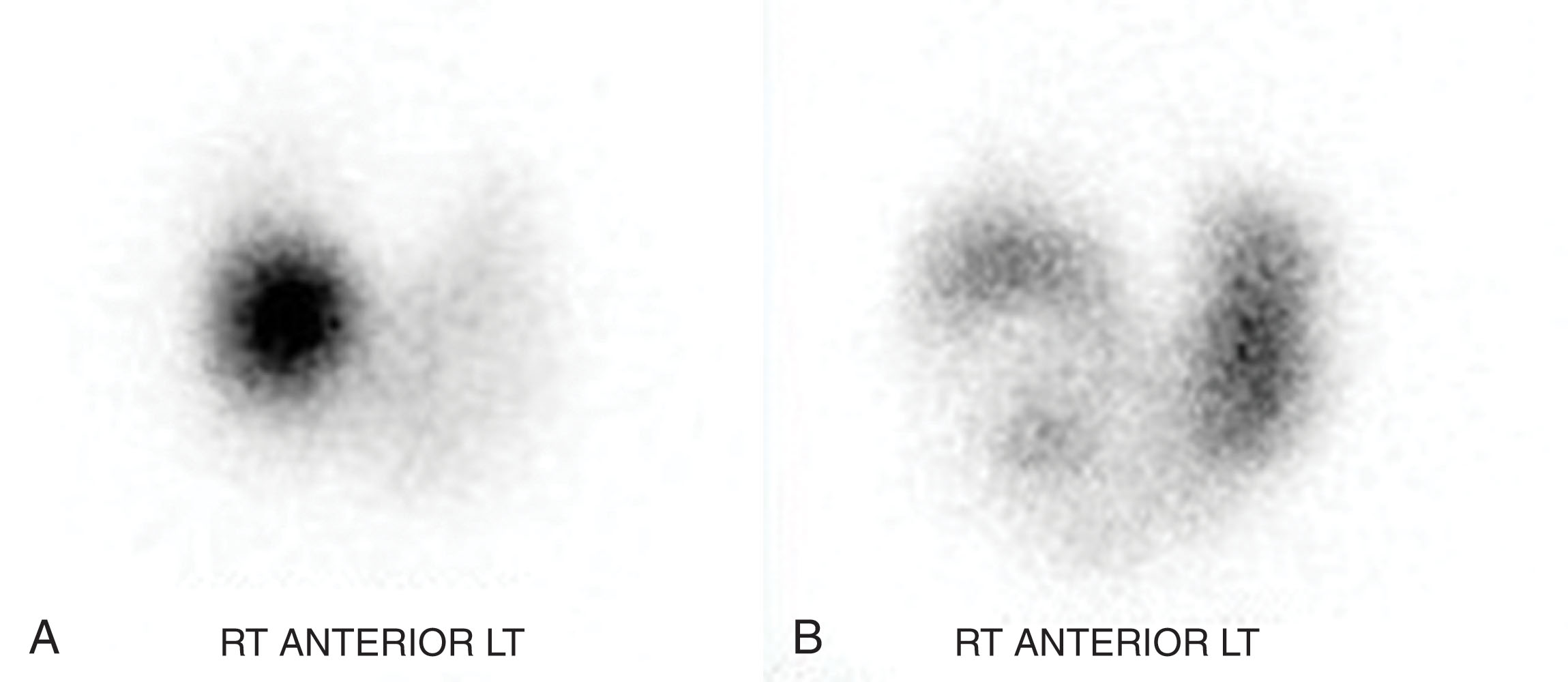
Other imaging modalities for thyroid include computed tomography (CT) and magnetic resonance imaging (MRI) to determine thyroid size, shape, position, and imaging characteristics of masses within the gland and neck area.
No patient preparation is required for thyroid sonography. The sonographer should review the examination indication and the available imaging results (i.e., previous thyroid sonography, scintigraphy, CT, or MRI). A thorough patient clinical history should be obtained before the sonographic examination. Pertinent information includes results of the physician’s physical examination (e.g., palpable nodule or goiter), pain/duration, history of hyperthyroidism, hypothyroidism, thyroiditis and symptoms related to thyroid disorders, thyroid medications, or surgery. If the patient has a previous history of cancer, along with prior history of radiation or surgery to the neck and upper chest, this should be noted in the examination record. If the patient has a palpable mass, ask the patient to indicate the location or obtain a description of the palpable area from the ordering physician.
The examination procedure should always be explained to the patient before scanning. The patient is placed in the supine position with a pillow or pad under both shoulders to provide moderate hyperextension of the neck with chin elevated to place the thyroid more horizontal and bring the inferior portion of the gland more superior for visualization ( Fig. 22.3 ). If the lower pole of the thyroid is still difficult to view, having the patient swallow will move the entire gland superiorly. Having the patient elevate the chin superiorly and turn to the opposite side will enable better visualizing of each lobe. It is important to be conscious of elderly patients or those who may experience dizziness or neck strain and make positioning adjustments as needed.
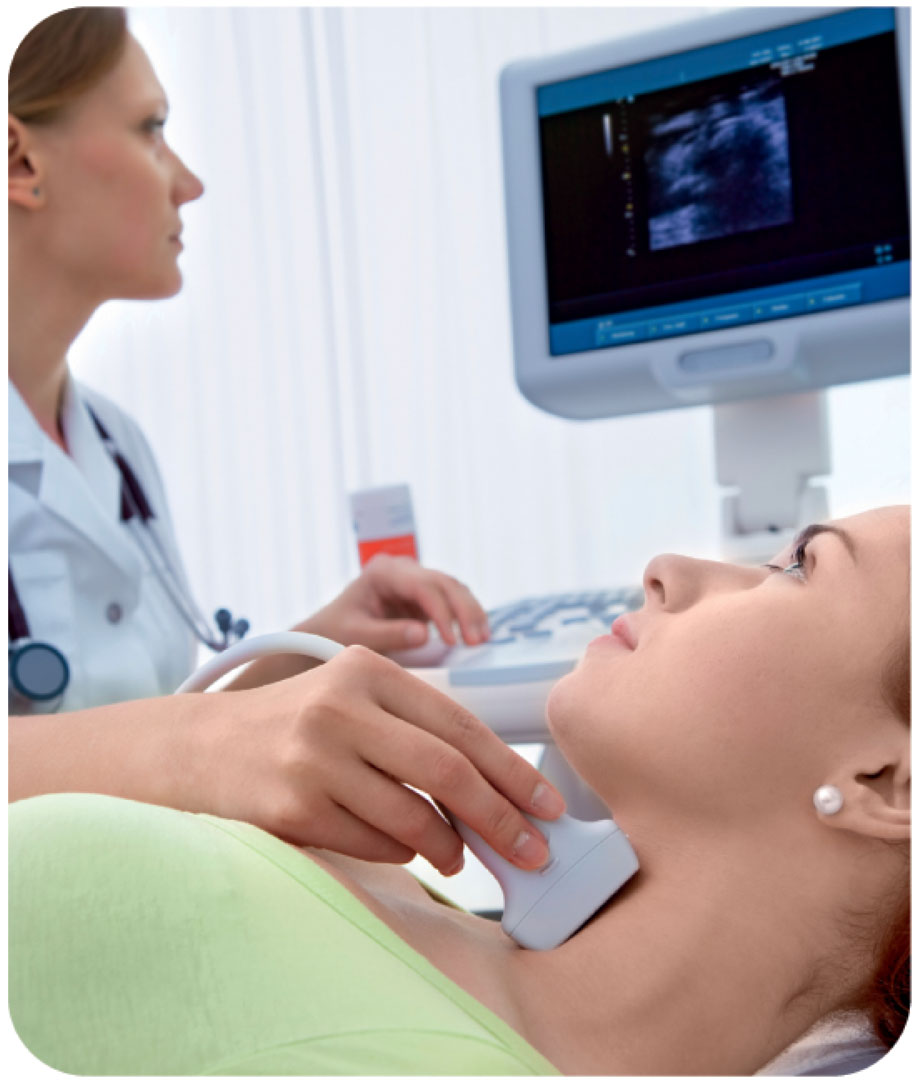
A high-frequency (7 to 15 MHz) linear array transducer should be used, selecting the highest frequency to penetrate the entire thyroid and surrounding musculature. Each lobe and isthmus should be carefully surveyed in transverse and longitudinal planes. The survey should also extend superior, inferior, and lateral of the thyroid gland to identify and document any enlarged cervical lymph nodes ( Fig. 22.4 ). The transverse survey is completed scanning from above to below the thyroid to note gland symmetry. Multiple transverse images of the superior, mid, and inferior levels of each lobe are imaged and labeled accordingly ( Fig. 22.5 ). Virtual convex, split screen, or panoramic features may provide imaging of larger glands ( Fig. 22.6 ).
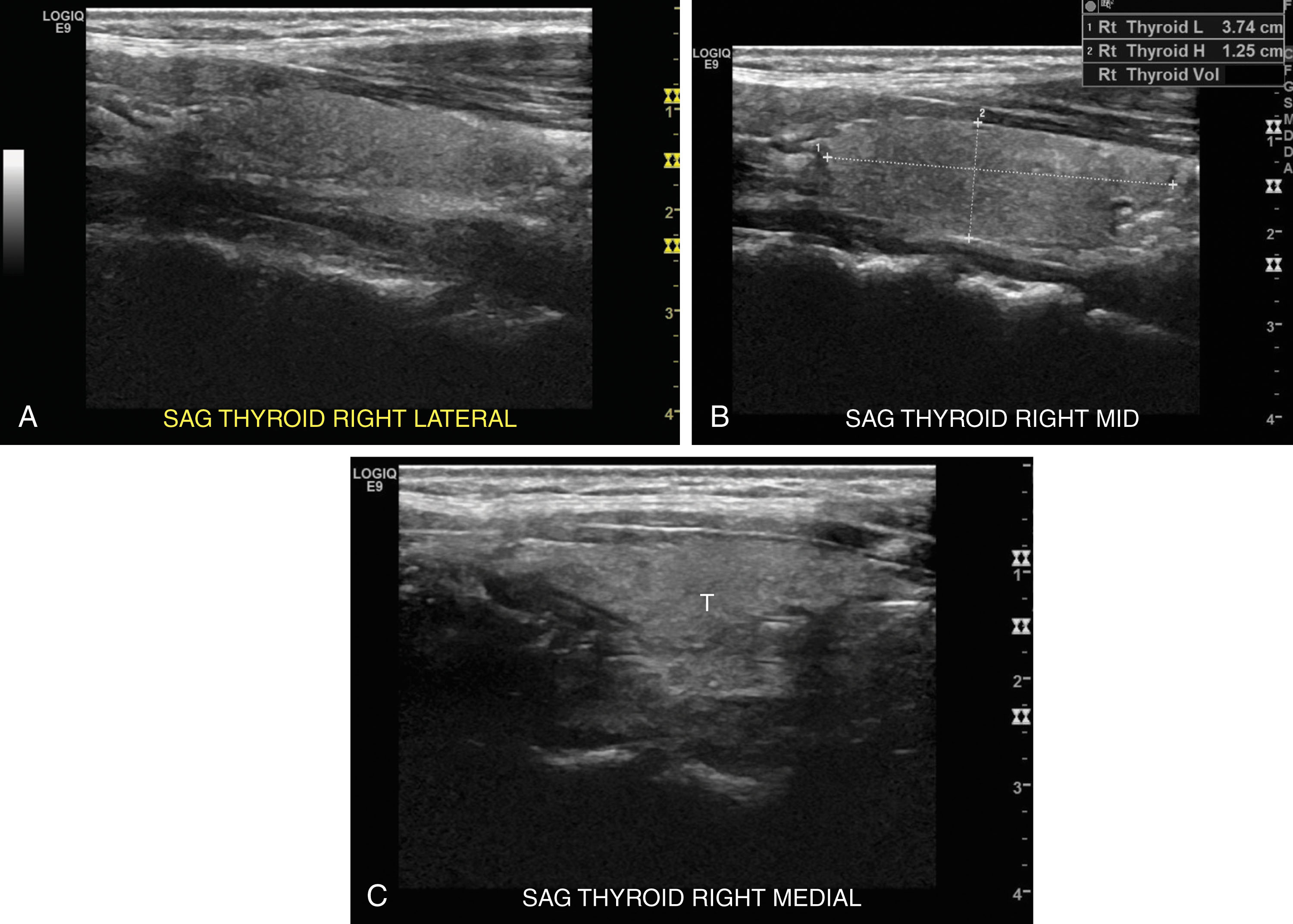
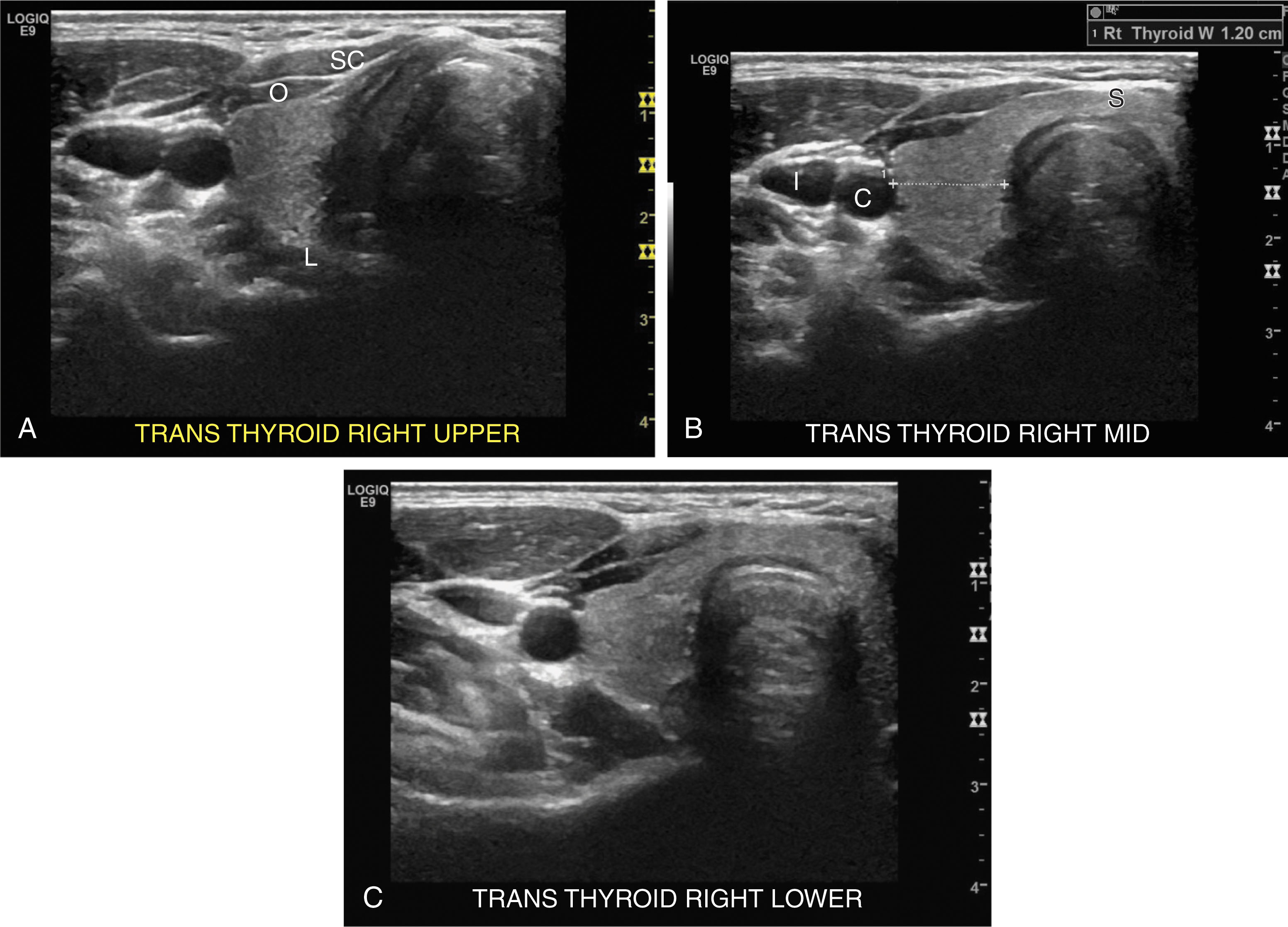
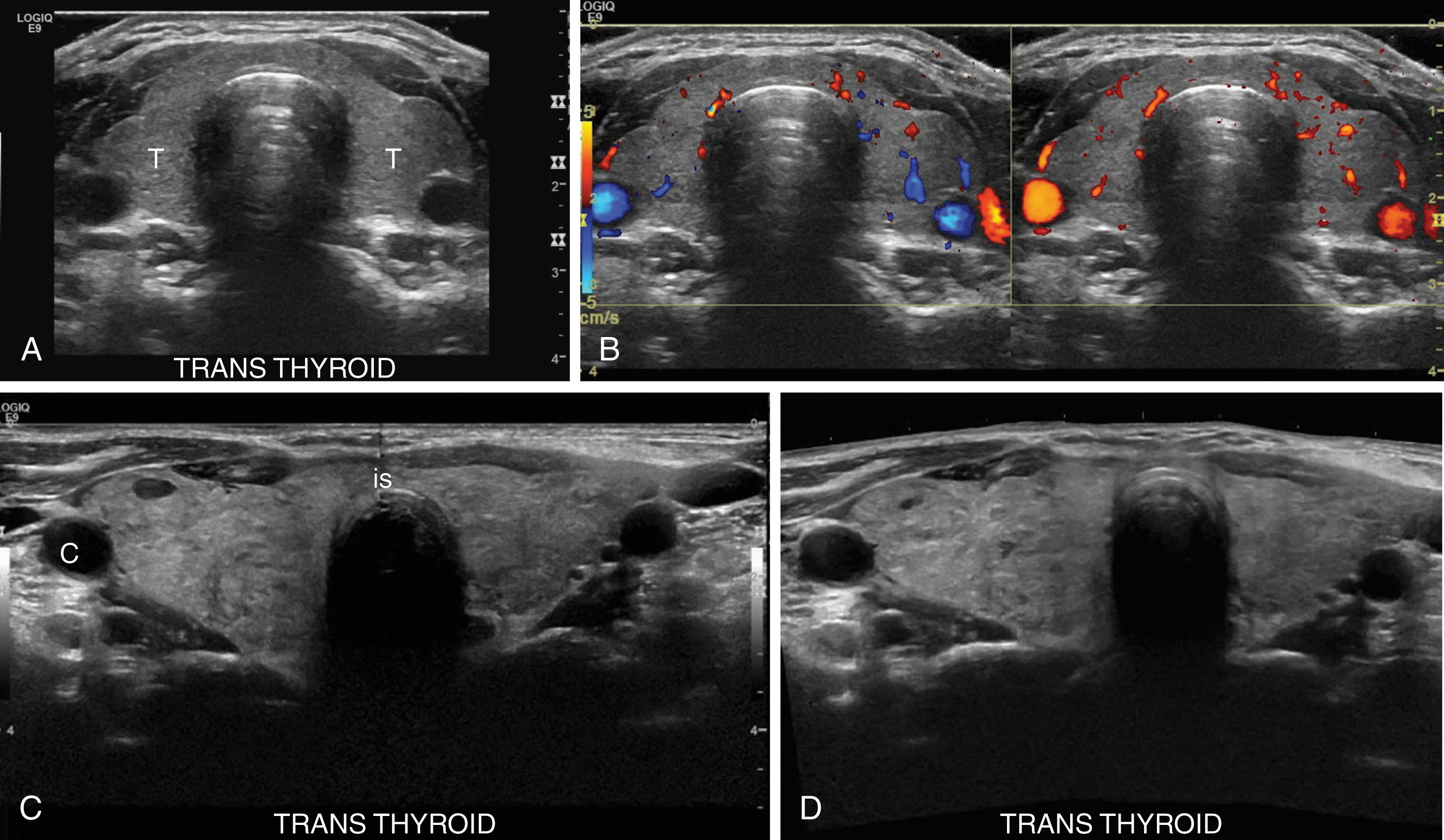
Transverse and longitudinal survey of the isthmus is completed with images recorded and labeled. Transverse imaging landmarks include the trachea, common carotid artery, and internal jugular vein. The trachea is noted in the midline posterior to the isthmus with posterior shadowing. The common carotid artery is a circular, pulsatile structure directly lateral and adjacent to the gland. The oval-shaped internal jugular vein lies lateral to the common carotid artery ( Fig. 22.7 ).
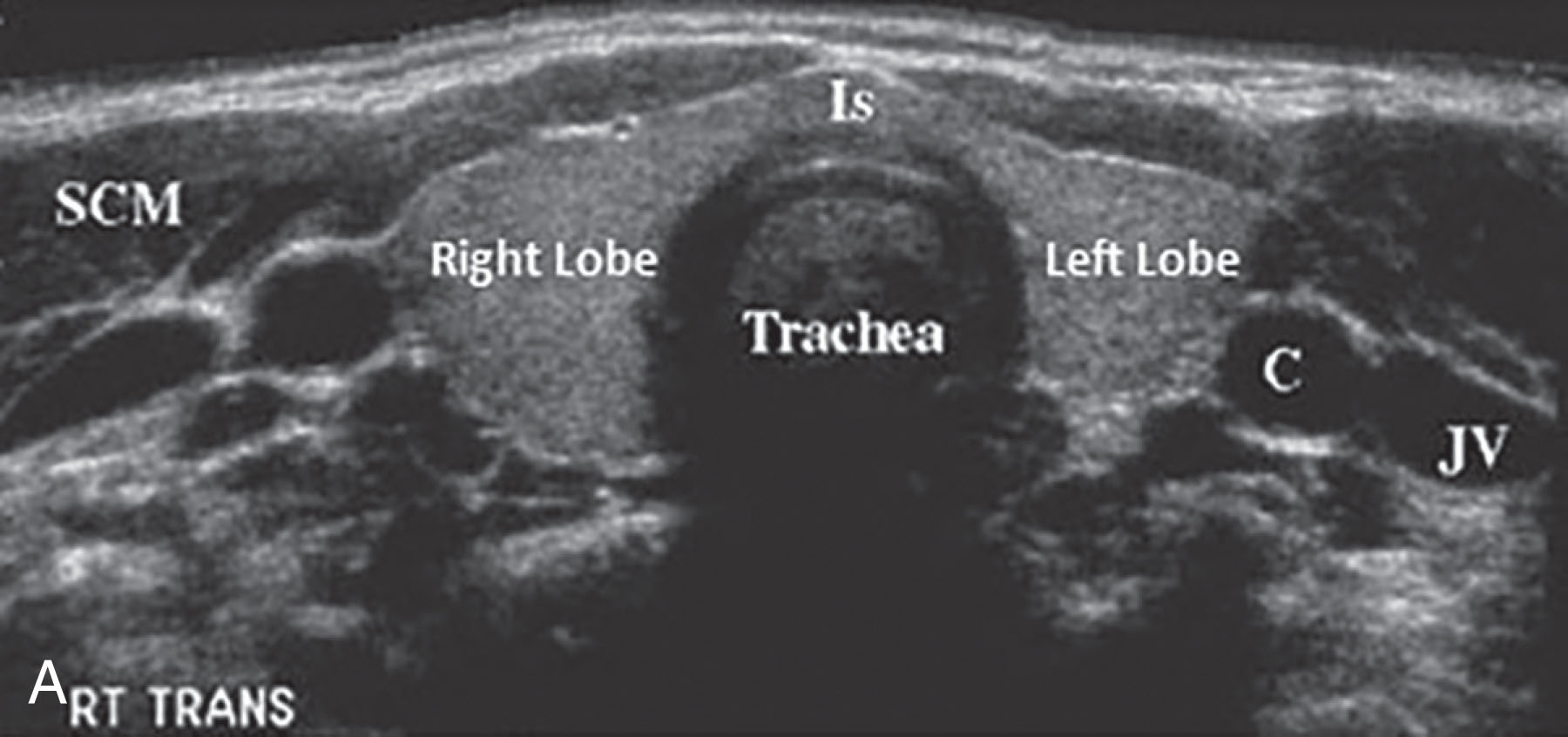
To locate the longitudinal scan plane of the thyroid gland, it is helpful to align the longitudinal axis of the common carotid artery and slide medially. Longitudinal survey is completed by scanning from the lateral to internal jugular vein to the midline isthmus. Multiple longitudinal images of the lateral, mid, and medial portions of each lobe are imaged individually and labeled accordingly (see Fig. 22.4 ). On longitudinal scans, landmarks include the recurrent laryngeal nerve and inferior thyroid artery, which may be seen between the thyroid lobe and esophagus on the left and between the thyroid lobe and longus colli muscle on the right.
During the examination, obtain three measurements of each lobe for volume calculations at maximum length, AP, and width of gland. The AP measurement of isthmus should be imaged in the transverse plane ( Fig. 22.8 ). Examination protocol should also include color Doppler images of both transverse and longitudinal planes of the middle portion of the thyroid demonstrating gland vascularity (see Fig. 22.6B ). A low pulse repetition frequency is chosen for the color Doppler scale to distinguish all vascular structures. Power Doppler or pulsed wave Doppler may also contribute information on vascular hemodynamics and should be obtained as needed.
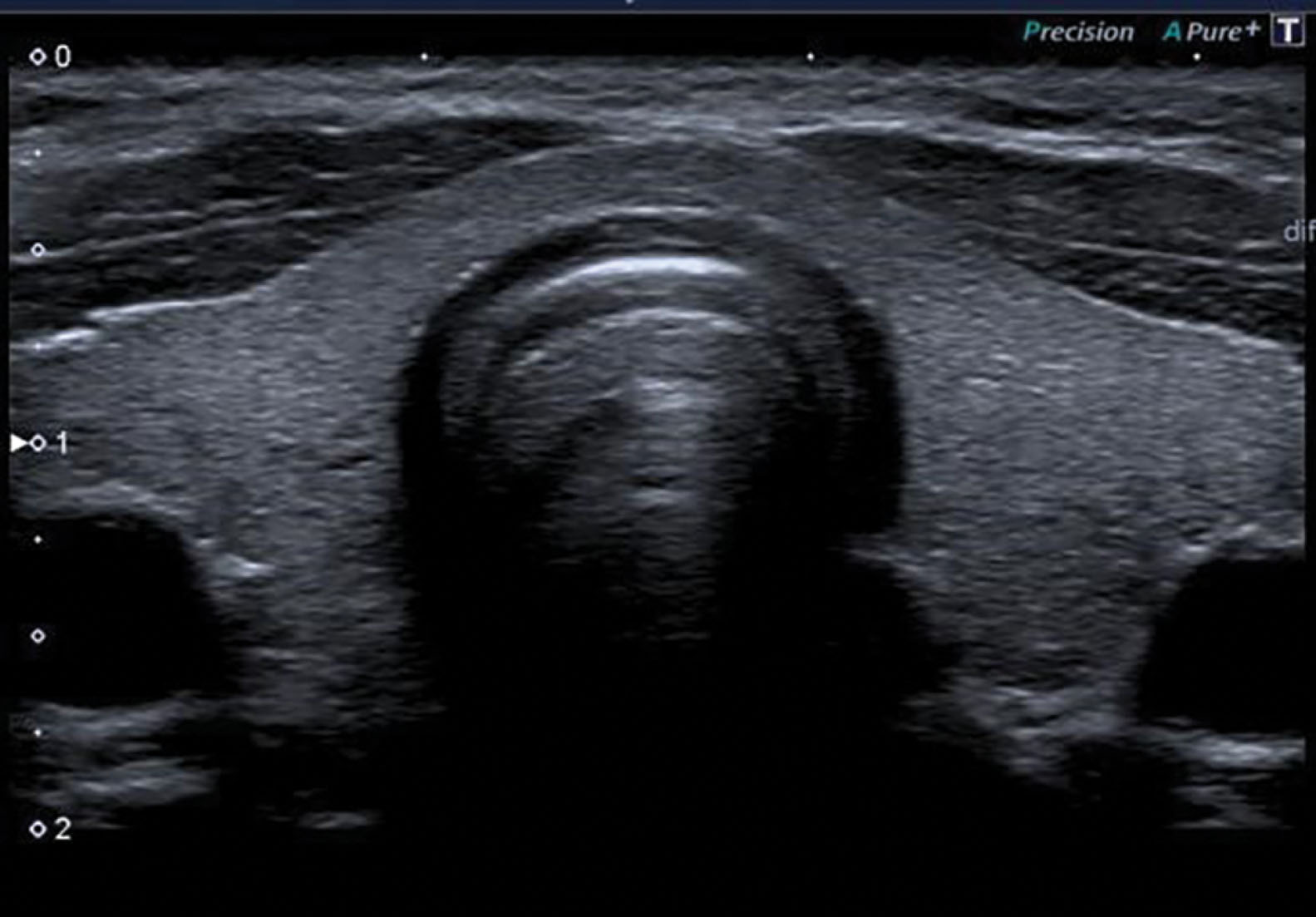
Normal sonographic appearance of the thyroid gland is fine homogeneous echotexture that is slightly more echogenic than the surrounding musculature. The thyroid capsule is imaged as a thin, hyperechoic line that outlines the gland from surrounding relational anatomy. The air-filled trachea is demonstrated as a curvilinear structure with acoustic shadowing. Multiple, tiny vascular structures may be seen as tubular anechoic structures more apparent at the periphery and upper and lower poles within the gland representing the superior and inferior thyroid arteries and veins. Normal pulsed Doppler spectrum will demonstrate peak systole velocities of 20 to 40 cm/sec in the major thyroid arteries and 15 to 30 cm/sec in intraparenchymal arteries.
The surrounding musculature of the thyroid gland is hypoechoic compared with the normal thyroid parenchyma. The strap muscles are anterior to the gland with the larger sternocleidomastoid muscle imaged more anterolateral to the gland. The hypoechoic longus colli muscle is found posterior to each lobe of the thyroid (see Fig. 22.5 ). The recurrent laryngeal nerve and the inferior thyroid artery pass in the angle between the trachea, esophagus, and thyroid lobe. The esophagus is adjacent to the trachea, with a hypoechoic rim surrounding an echogenic center more commonly visualized slightly to the left of the midline, next to the trachea, with peristalsis noted in real time with patient swallowing ( Fig. 22.9 ).
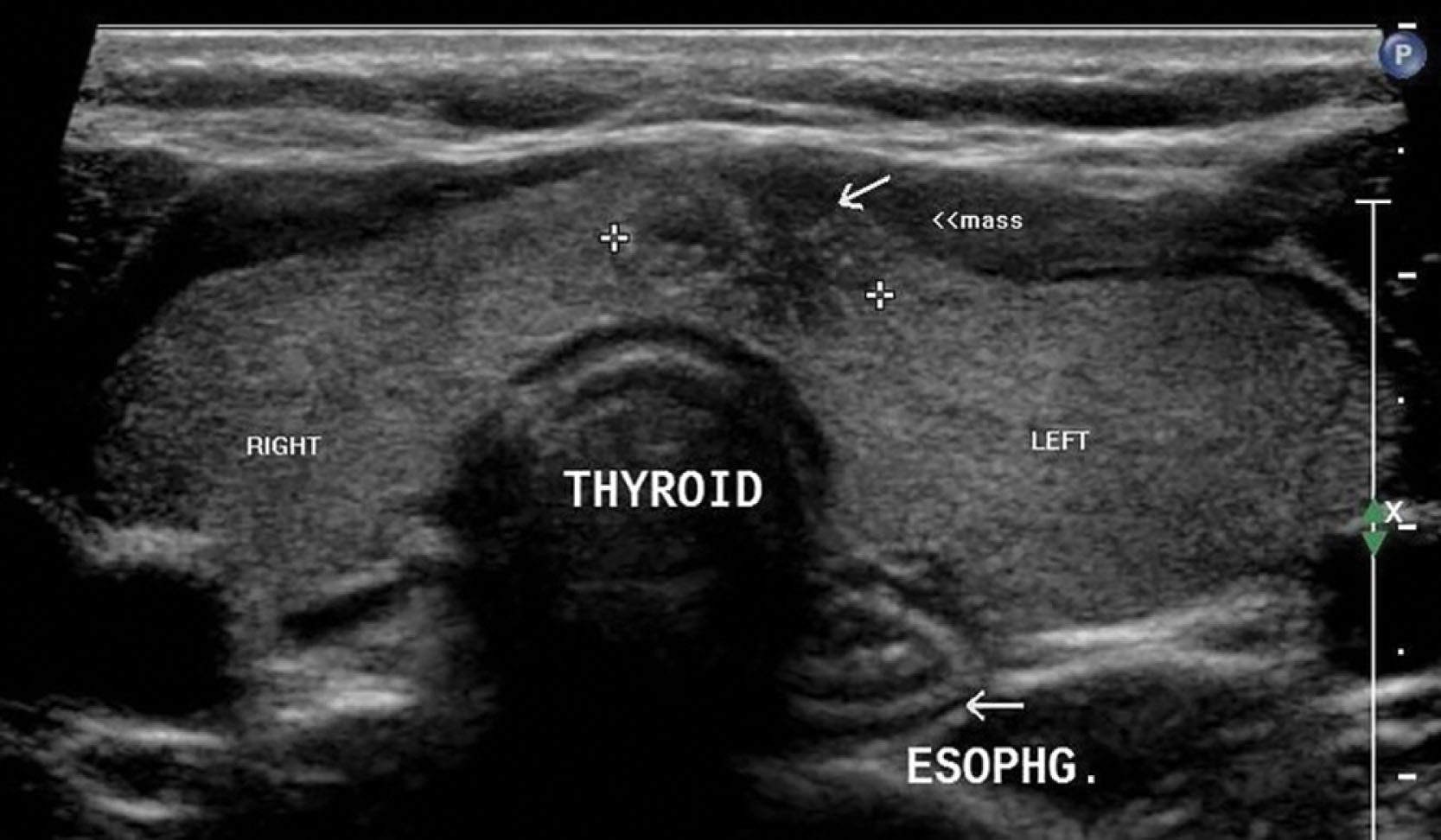
Congenital abnormalities of the thyroid gland include aplasia, hypoplasia, and ectopic locations of the thyroid gland. Aplasia is congenital absence of gland and may affect one lobe, the isthmus, or the entire gland. Complete absence of the thyroid gland has a severe impact on physical and mental development. Hypoplasia refers to underdevelopment of any part of the gland and may be associated with congenital hypothyroidism.
Ectopic locations may be present along the path of embryonic descent if the thyroid migrates too little or too far. Most commonly, ectopic tissue may be present posterior to the tongue (sublingual or lingual thyroid). Other ectopic locations include larynx (prelaryngeal thyroid) or mediastinum (substernal thyroid). Scintigraphy is best for visualization of ectopic thyroid tissue.
Pathology identified in the thyroid and adjacent neck structures should always be documented in both longitudinal and transverse scan planes. The gland measurements and volume should be obtained and parenchyma defined as homogeneous or heterogeneous. If a nodule is visualized, the location should be noted in relationship to gland (e.g., right thyroid transverse upper; left thyroid long lateral) and also measured in three dimensions. The sonographic appearance should be demonstrated and echogenicity described (e.g., hypoechoic, hyperechoic, and whether cystic, complex cystic, solid, and/or presence and type of calcifications). In addition, the nodule borders should be described as ill defined or well defined and whether a hypoechoic halo is surrounding the nodule. It is not uncommon for sonography to demonstrate multiple nodules (MNG) in a gland. Vascularity should also be demonstrated with color or power Doppler and possibly pulsed wave Doppler.
Approximately 80% of nodular thyroid disease is due to hyperplasia or compensatory hypertrophy forming micronodules and macronodules of the gland. This can lead to overall enlargement (goiter) or MNG that may be unilateral or bilateral; it is seen more commonly in women with increasing age. When evaluated microscopically, most benign nodules are classified as hyperplastic, adenomatous, and colloid type nodules.
The most common cause of thyroid disorders worldwide is iodine deficiency, which leads to nodule and goiter formation. Often the gland is able to keep up with the demand and provide normal release of thyroid hormones. However, in some cases, the gland lags behind the demand and the patient develops hypothyroidism. In the first stage, hyperplasia occurs; in the second stage, colloid involution occurs. Progression of this process leads to an asymmetric and multinodular gland with areas of hemorrhage and calcification ( Fig. 22.10 ).
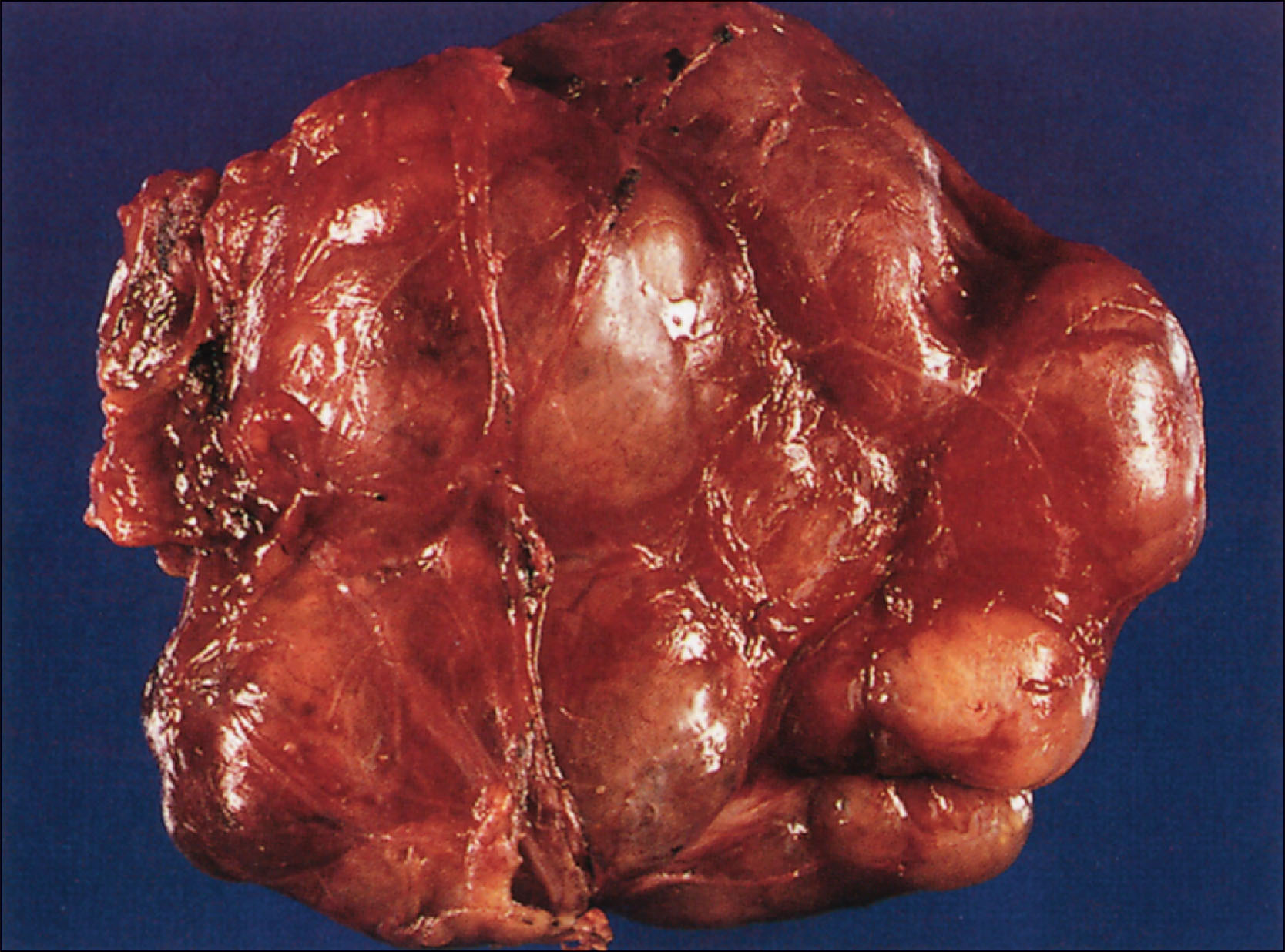
An endemic goiter may affect large groups of people in a specific geographic area where iodine levels in the soil, food, and water are low (e.g., mountainous areas or the Great Lakes region). Certain types of food (cabbage, turnips, and other related vegetables) when ingested in large quantities may increase blood synthesis of T 3 and T 4 but increase TSH secretion from the pituitary gland. This dietary deficiency can cause hyperplasia and hypertrophy and can promote goiter formation in the thyroid gland. Iodized salt as a dietary supplement usually corrects the iodine deficiency. In areas not deficient in iodine, autoimmune processes (Graves disease or Hashimoto thyroiditis) are believed to be the basis for most cases of thyroid disease.
A toxic goiter is a condition in which nodular enlargement causes hyperactivity of the thyroid gland and hyperthyroidism. Nontoxic (simple) goiter occurs when nodular enlargement is not associated with thyroid dysfunction (hypothyroidism or hyperthyroidism).
A goiter may first present visibly as an anterior protrusion on the neck on thin patients. The clinician may palpate an enlarged thyroid during a physical examination. A goiter may become very large, compressing the esophagus with difficulty swallowing (dysphagia), pressure on the trachea (inspiratory stridor) or neck veins (venous distention), or laryngeal nerve (hoarseness). Patients may also present with clinical symptoms of hypothyroidism or hyperthyroidism. Table 22.3 lists the common findings, sonographic appearances, and differential considerations for nodule thyroid disease.
| Clinical Findings | Sonographic Appearances | Differential Considerations |
|---|---|---|
| Nontoxic Simple Goiter | ||
| Thyroid enlargement | Sometimes smooth, sometimes nodular; possible compression of surrounding structures |
|
| Toxic Multinodular Goiter | ||
| Thyroid enlargement | Enlarged inhomogeneous gland; can have focal scarring, focal ischemia, necrosis, and cyst formation |
|
| Graves Disease | ||
| Diffuse toxic goiter | Diffusely homogeneous and enlarged |
|
| Thyroiditis | ||
| Swelling and tenderness of the thyroid; later, hypothyroidism | Homogeneous enlargement with nodularity; later, inhomogeneous | Neoplasm |
| Benign Lesions | ||
| Cysts | ||
| Solitary nodules or multiple nodules | Anechoic areas, echogenic fluid, or moving fluid levels | Toxic multinodular goiter |
| Adenoma | ||
| Usually euthyroid or hyper-thyroidism | Compression of adjacent structures; fibrous encapsulation; ranges from anechoic to hyperechoic; may have halo | Graves disease |
Sonographic appearance of nodular thyroid disease will vary. There can be diffuse symmetric gland enlargement ( Fig. 22.11 ) or localized discrete nodule(s). Enlargement can involve both lobes and isthmus with several nodules, described as an MNG ( Fig. 22.12 ), or one lobe. Nodules can also vary in echogenicity (i.e., isoechoic, hyperechoic, and complex cystic) due to fibrosis, colloid, focal scarring, ischemia, cystic degeneration, or calcification formation. Nodules may present as poorly circumscribed or well defined and encapsulated by a thin, peripheral hypoechoic halo due to surrounding compressed tissue and should be documented ( Fig. 22.13 ). Hyperfunctioning nodules usually demonstrate increased perinodular and intranodular vascularity on color or power Doppler as seen in Fig. 22.12B .
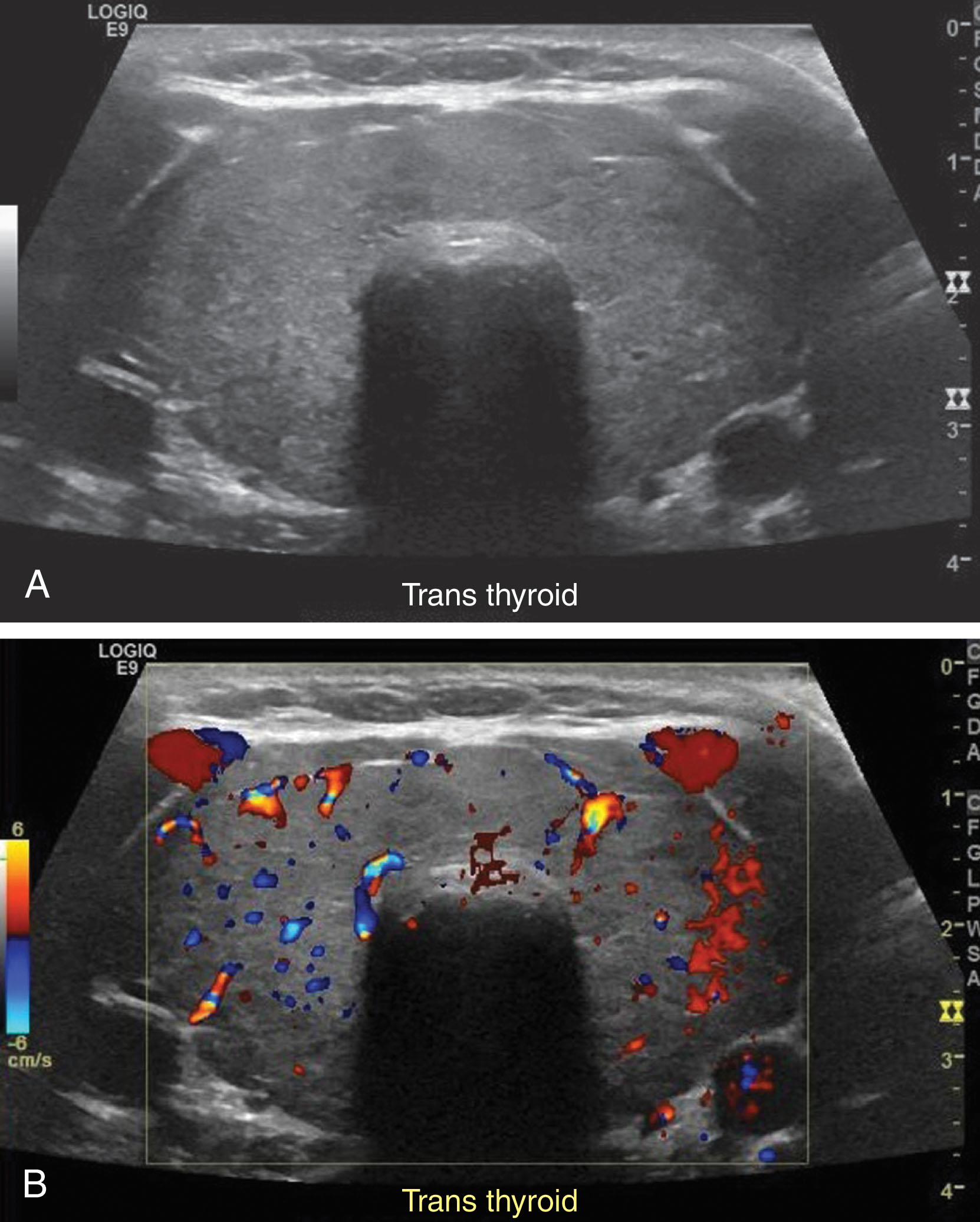
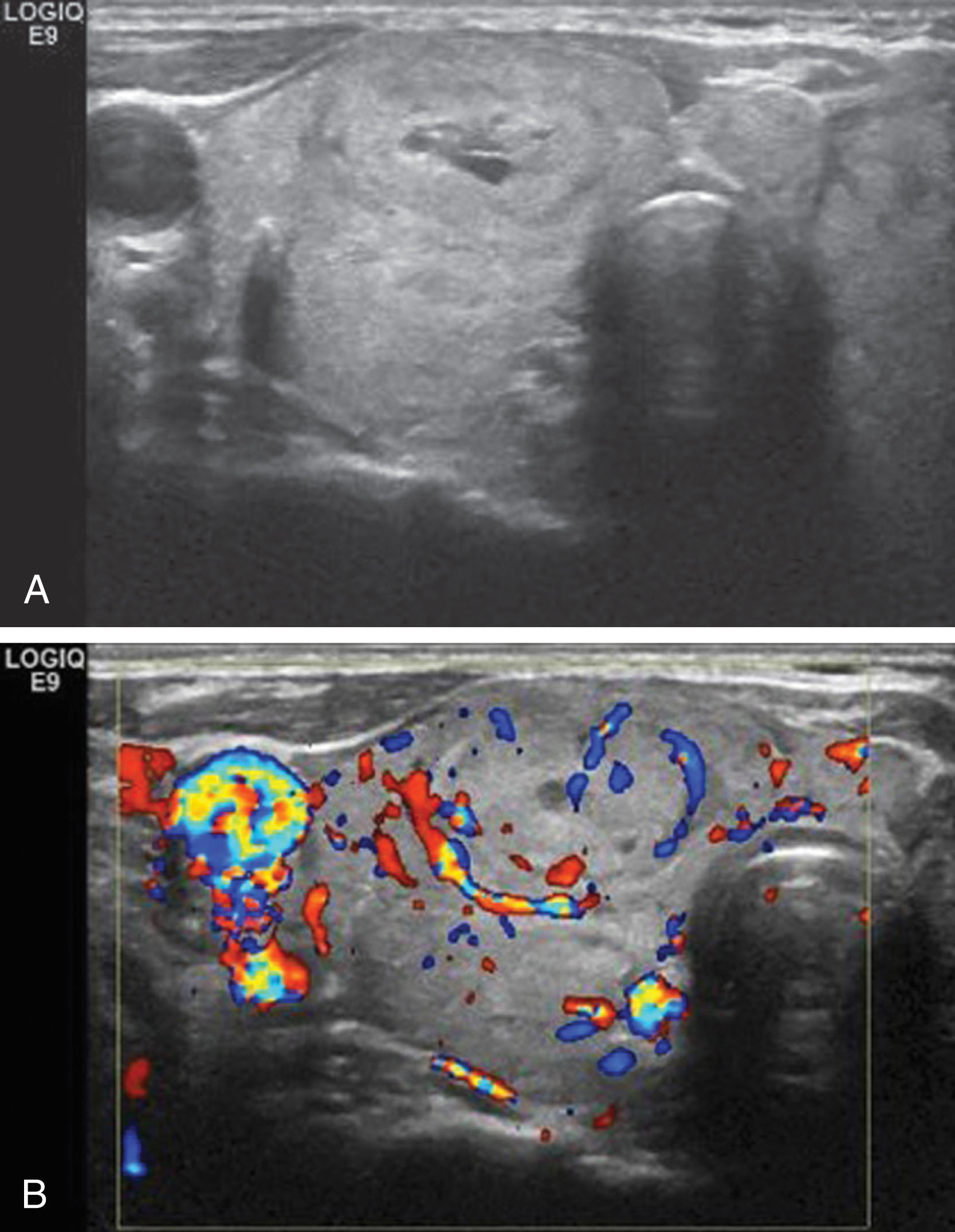
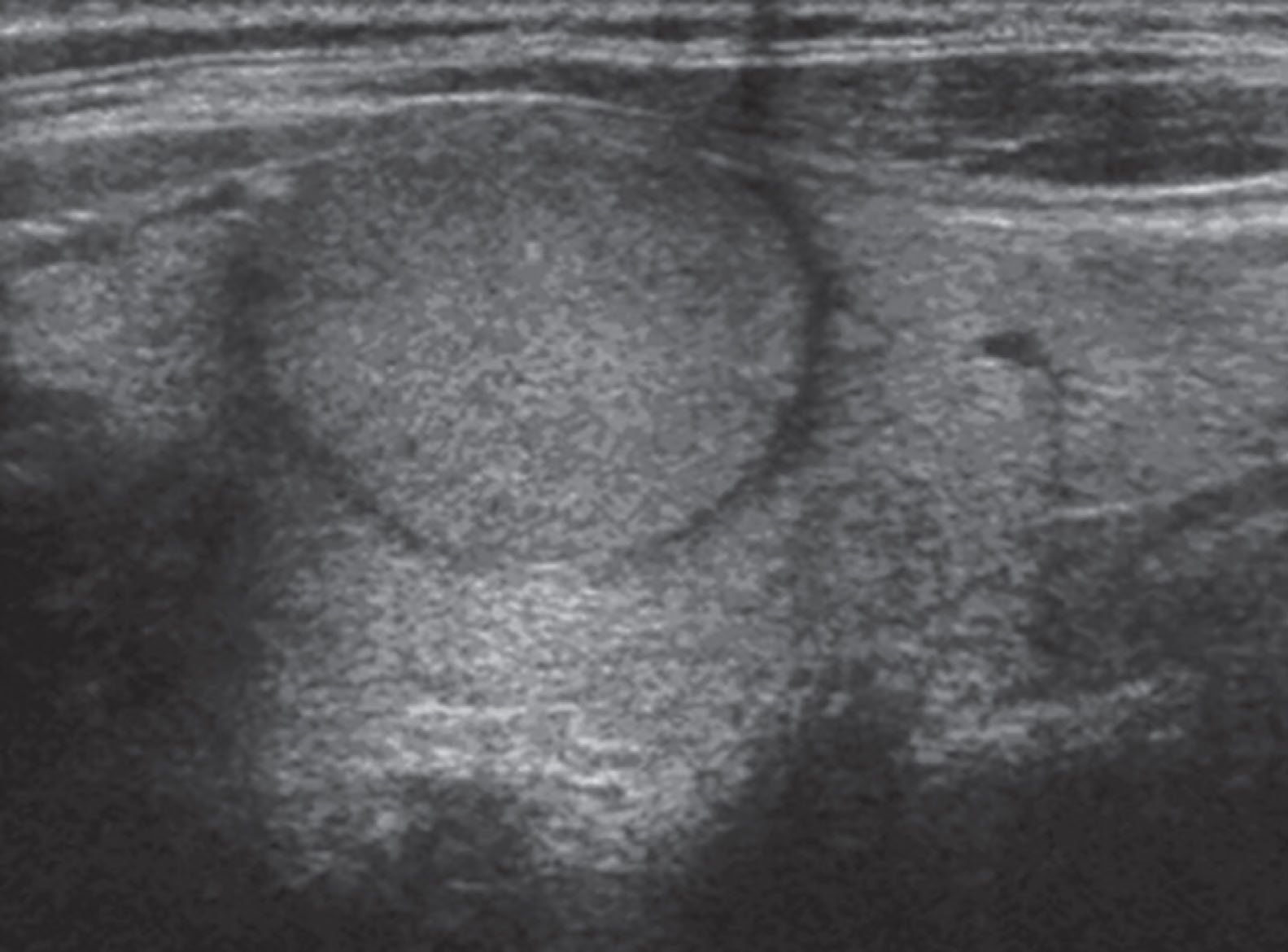
A discrete, palpable nodule of the thyroid gland is the most common indication for a thyroid sonography. Nodular thyroid disease is frequently encountered in the adult population, with up to 7% found to have benign nodule, with women affected more frequently than men. Sonography is useful to locate the palpable nodule and describe sonographic appearance.
Become a Clinical Tree membership for Full access and enjoy Unlimited articles
If you are a member. Log in here